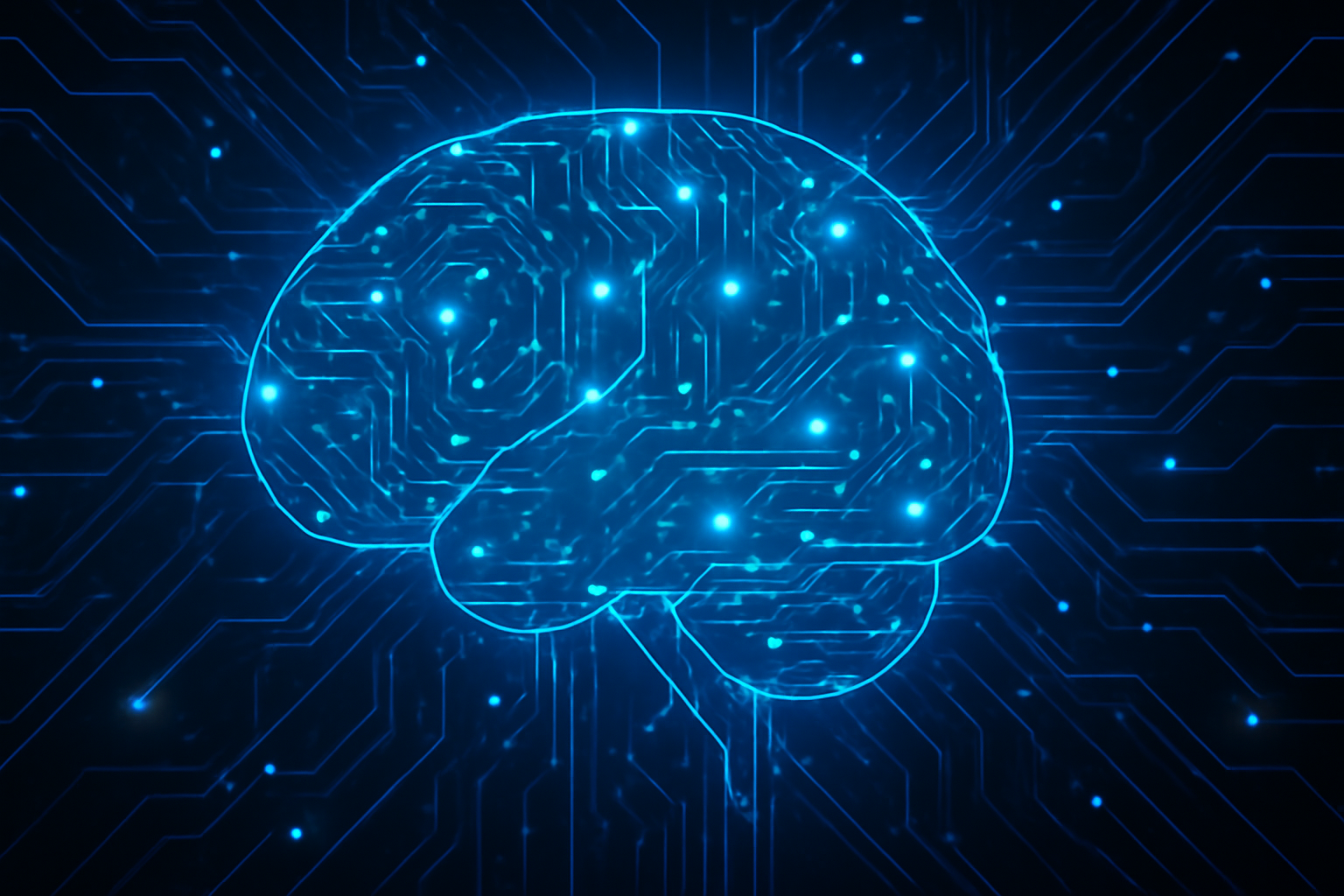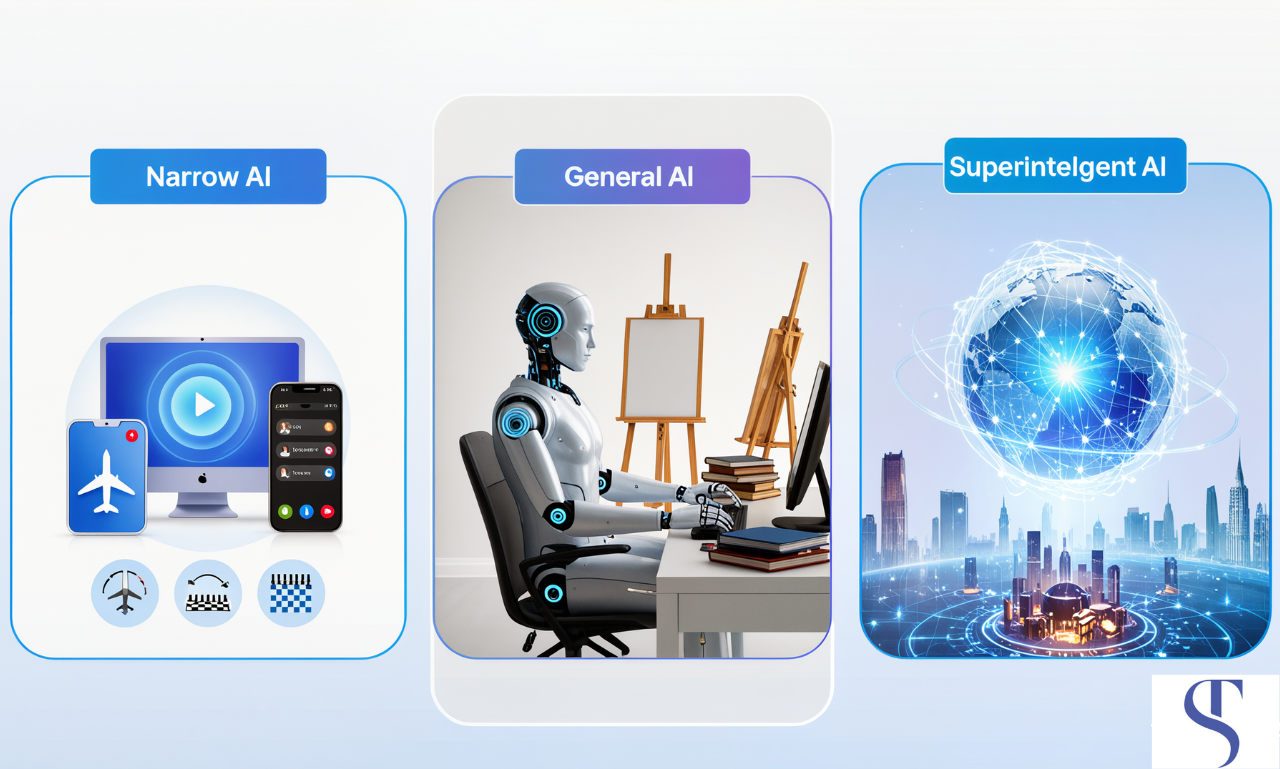Artificial Intelligence (AI) refers to the simulation of human intelligence in machines. These machines are programmed to think, learn, and problem-solve in ways similar to humans. AI systems use algorithms and data to make decisions, recognize patterns, and improve over time without direct human intervention.
A Simple Explanation of AI
In its simplest form, AI allows machines to perform tasks that would normally require human intelligence. These tasks range from recognizing speech and images to making complex decisions based on vast amounts of data. AI is not just one technology but a collection of tools and techniques, each aimed at solving different types of problems.

Types of Artificial Intelligence
AI is often classified into three broad categories:
1. Narrow AI (Weak AI)
Narrow AI is designed to perform a specific task. It is the most common form of AI and is used in systems like voice assistants (e.g., Siri), recommendation systems (e.g., Netflix), and chatbots.
Example:
-
Google Search: Google uses AI to provide relevant search results based on the keywords you enter, analyzing countless variables in real time to rank pages.
2. General AI (Strong AI)
General AI is still theoretical. It refers to a machine that can perform any intellectual task that a human can do. It would have the ability to reason, solve complex problems, and even understand emotions.
Example:
-
Human-Like Machines: Machines like those depicted in movies (e.g., the robots in Ex Machina) would represent general AI.
3. Superintelligent AI
Superintelligent AI goes beyond human intelligence. It refers to machines that can outperform humans in every aspect, from creativity to decision-making. This concept is currently speculative and has yet to be realized.
Example:
-
Sci-Fi depictions of superintelligent AI (e.g., HAL 9000 in 2001: A Space Odyssey).

How Does Artificial Intelligence Work?
AI systems operate through the following steps:
1. Data Collection
AI systems require vast amounts of data to learn from. The more data they are exposed to, the better they can identify patterns and make predictions. This data can come from various sources such as sensors, social media, transactions, and more.
2. Processing and Learning
AI uses algorithms to process the data. These algorithms allow the system to “learn” from past experiences. For example, a recommendation engine learns your preferences by analyzing your past behavior.
3. Decision Making
Once the system has processed the data, it makes decisions or predictions based on the patterns it has learned. In AI, this decision-making can range from something as simple as recommending a product to complex tasks like diagnosing medical conditions.
4. Improvement
AI systems continually improve as they are exposed to more data. They refine their processes over time to provide more accurate results.
Real-World Examples of AI
AI is already a significant part of our daily lives. Here are a few examples of how it’s being used in various industries:
1. Healthcare
AI is revolutionizing healthcare with applications like diagnostic tools, robotic surgeries, and personalized treatment plans. AI-powered systems can analyze medical data to detect diseases earlier and more accurately.
Example:
-
IBM Watson Health: Watson is an AI system used in healthcare that assists doctors in diagnosing diseases and suggesting treatment plans by analyzing medical literature and patient data.
2. Finance
In finance, AI is used for risk assessment, fraud detection, and automated trading. AI systems can analyze financial data and predict market trends faster than humans.
Example:
-
Credit Scoring: Banks use AI to assess the creditworthiness of individuals by analyzing a variety of factors, including spending habits and financial history.
3. Retail
AI helps retailers optimize inventory, personalize shopping experiences, and improve customer service. AI systems predict which products are in demand and suggest items to customers based on their preferences.
Example:
-
Amazon’s Recommendation Engine: Amazon uses AI to recommend products based on what you’ve purchased, searched for, and viewed on their platform.
4. Transportation
AI is integral to the development of autonomous vehicles and traffic management systems. These systems can analyze road conditions, predict traffic patterns, and safely navigate without human intervention.
Example:
-
Tesla Autopilot: Tesla’s AI-powered system allows cars to drive themselves, adjusting speed and direction based on real-time data.

Benefits of Artificial Intelligence
1. Increased Efficiency
AI can automate repetitive tasks, allowing businesses and individuals to save time and resources. This leads to improved productivity.
2. Cost Savings
AI reduces the need for human labor in certain tasks, which can lead to cost savings for companies. It can also predict maintenance needs, reducing downtime.
3. Improved Decision Making
AI systems can analyze large datasets quickly and provide insights that might take humans much longer to uncover.
4. Personalization
AI can deliver highly personalized experiences for users, from custom-tailored product recommendations to personalized marketing campaigns.
Challenges and Ethical Concerns
Despite its numerous advantages, AI presents some challenges and ethical concerns:
1. Job Displacement
As AI automates more tasks, there is concern about the loss of jobs, especially in fields like manufacturing and customer service.
2. Bias and Fairness
AI systems can inherit biases from the data they are trained on. This can lead to discriminatory practices, especially in sensitive areas like hiring and lending.
3. Privacy Issues
AI systems collect and process vast amounts of personal data. This raises concerns about data privacy and how that data is used or misused.
4. Accountability
If an AI system makes a mistake, it’s often unclear who is responsible. This raises questions about accountability, especially in critical areas like healthcare and autonomous driving.
FAQ
1. Is Artificial Intelligence the Same as Machine Learning?
No, AI is the broader concept, while machine learning (ML) is a subset of AI. ML focuses on the idea that systems can learn from data and improve their performance over time without being explicitly programmed.
2. Will AI Replace Human Workers?
While AI will automate many tasks, it’s unlikely to fully replace human workers. Instead, AI is expected to augment human capabilities, allowing workers to focus on more complex and creative tasks.
3. Can AI Be Trusted?
AI can be trusted in certain applications, but it’s crucial to ensure that it is properly designed, tested, and monitored. Ethical considerations, like fairness and transparency, should always be a priority.
Embracing the Future of AI
Artificial Intelligence is changing the world in profound ways, from the way we work to the way we interact with technology. While there are challenges to address, such as bias and job displacement, the potential benefits of AI—improved efficiency, cost savings, and personalized experiences—are immense. As AI continues to evolve, it’s clear that it will play an increasingly central role in our lives.
Stay Updated on AI Trends
If you’re interested in learning more about how AI impacts your industry or how to leverage it for your business, subscribe to our newsletter for the latest insights.


